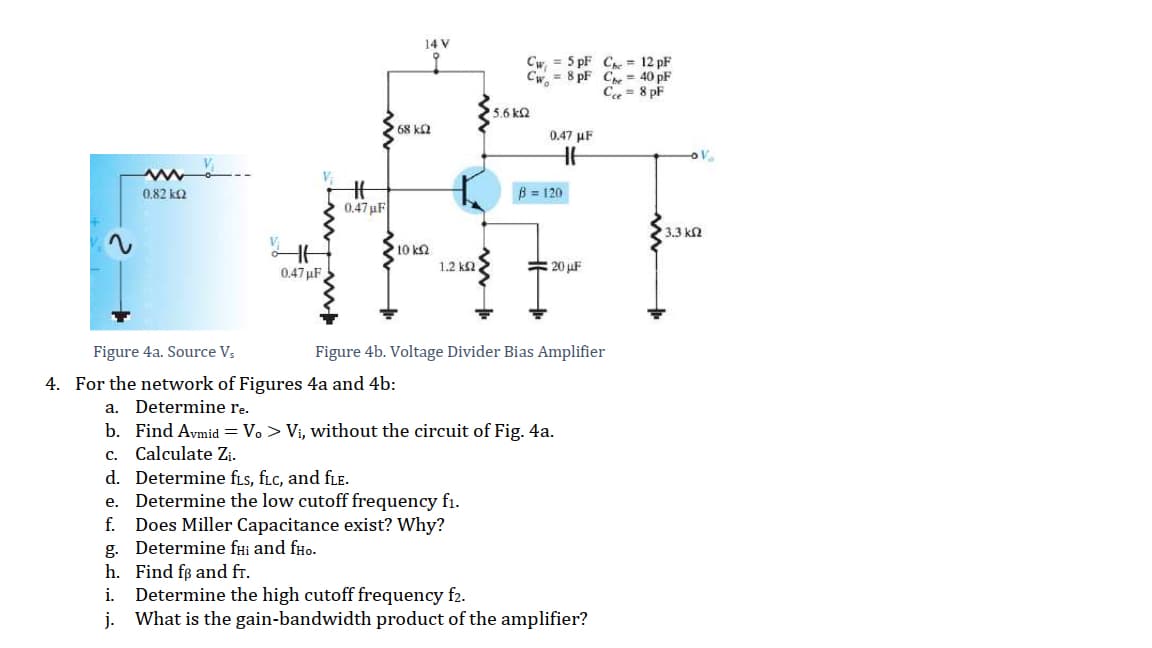14 V Cw = 5 pF C = 12 pF Cw = 8 pF C= 40 pF C = 8 pF 5.6 kQ 68 ka 0.47 uF 0.82 k2 B = 120 0.47 uF 3.3 kn 10 kn 1.2 k 20 uF 0.47 µF Figure 4a. Source V: Figure 4b. Voltage Divider Bias Amplifier For the network of Figures 4a and 4b: a. Determine re. b. Find Avmid = V. > Vi, without the circuit of Fig. 4a. c. Calculate Zi. d. Determine fis, fic, and fLE. e. Determine the low cutoff frequency f1. f. Does Miller Capacitance exist? Why? g. Determine fHi and fHo. h. Find fø and fr. i. Determine the high cutoff frequency f2. j. What is the gain-bandwidth product of the amplifier?
14 V Cw = 5 pF C = 12 pF Cw = 8 pF C= 40 pF C = 8 pF 5.6 kQ 68 ka 0.47 uF 0.82 k2 B = 120 0.47 uF 3.3 kn 10 kn 1.2 k 20 uF 0.47 µF Figure 4a. Source V: Figure 4b. Voltage Divider Bias Amplifier For the network of Figures 4a and 4b: a. Determine re. b. Find Avmid = V. > Vi, without the circuit of Fig. 4a. c. Calculate Zi. d. Determine fis, fic, and fLE. e. Determine the low cutoff frequency f1. f. Does Miller Capacitance exist? Why? g. Determine fHi and fHo. h. Find fø and fr. i. Determine the high cutoff frequency f2. j. What is the gain-bandwidth product of the amplifier?
Introductory Circuit Analysis (13th Edition)
13th Edition
ISBN:9780133923605
Author:Robert L. Boylestad
Publisher:Robert L. Boylestad
Chapter1: Introduction
Section: Chapter Questions
Problem 1P: Visit your local library (at school or home) and describe the extent to which it provides literature...
Related questions
Question

Transcribed Image Text:14 V
Cw = 5 pF Cre = 12 pF
Cw, = 8 pF Che = 40 pF
C = 8 pF
5.6 k2
68 ka
0.47 µF
%23
0.47 uF
0,82 kQ
B = 120
3.3 ka
10 k2
1.2 k2
# 20 uF
0.47 uF
Figure 4a. Source Vs
Figure 4b. Voltage Divider Bias Amplifier
4. For the network of Figures 4a and 4b:
a. Determine re.
b. Find Avmid = V. > Vi, without the circuit of Fig. 4a.
c. Calculate Z¡.
d. Determine fis, fLc, and fLe.
e. Determine the low cutoff frequency fi.
Does Miller Capacitance exist? Why?
g. Determine fHi and fHo.
h. Find fø and fr.
Determine the high cutoff frequency f2.
j. What is the gain-bandwidth product of the amplifier?
f.
i.
Expert Solution
This question has been solved!
Explore an expertly crafted, step-by-step solution for a thorough understanding of key concepts.
Step by step
Solved in 5 steps with 5 images

Knowledge Booster
Learn more about
Need a deep-dive on the concept behind this application? Look no further. Learn more about this topic, electrical-engineering and related others by exploring similar questions and additional content below.Recommended textbooks for you

Introductory Circuit Analysis (13th Edition)
Electrical Engineering
ISBN:
9780133923605
Author:
Robert L. Boylestad
Publisher:
PEARSON

Delmar's Standard Textbook Of Electricity
Electrical Engineering
ISBN:
9781337900348
Author:
Stephen L. Herman
Publisher:
Cengage Learning

Programmable Logic Controllers
Electrical Engineering
ISBN:
9780073373843
Author:
Frank D. Petruzella
Publisher:
McGraw-Hill Education

Introductory Circuit Analysis (13th Edition)
Electrical Engineering
ISBN:
9780133923605
Author:
Robert L. Boylestad
Publisher:
PEARSON

Delmar's Standard Textbook Of Electricity
Electrical Engineering
ISBN:
9781337900348
Author:
Stephen L. Herman
Publisher:
Cengage Learning

Programmable Logic Controllers
Electrical Engineering
ISBN:
9780073373843
Author:
Frank D. Petruzella
Publisher:
McGraw-Hill Education

Fundamentals of Electric Circuits
Electrical Engineering
ISBN:
9780078028229
Author:
Charles K Alexander, Matthew Sadiku
Publisher:
McGraw-Hill Education

Electric Circuits. (11th Edition)
Electrical Engineering
ISBN:
9780134746968
Author:
James W. Nilsson, Susan Riedel
Publisher:
PEARSON

Engineering Electromagnetics
Electrical Engineering
ISBN:
9780078028151
Author:
Hayt, William H. (william Hart), Jr, BUCK, John A.
Publisher:
Mcgraw-hill Education,